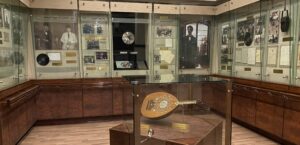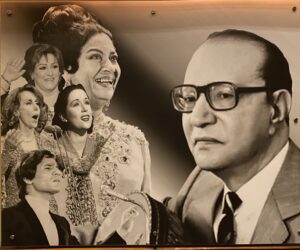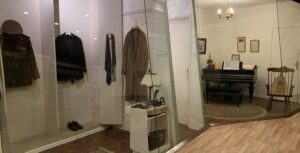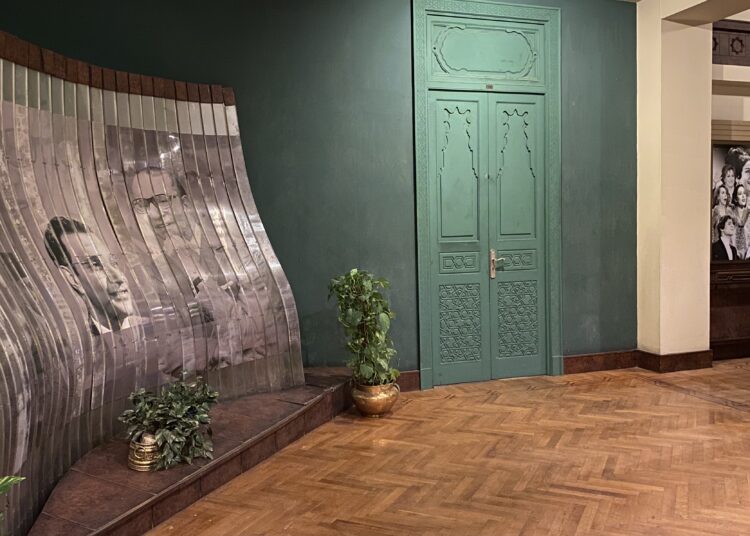At this place he studied music. At this place he sang in a concert attended by King Fouad (1922-1936). At this place, visitors learn more about the music legend Mohamed Abdel Wahab (1901-1991), prominent 20th-century singer, composer and actor.
The Mohamed Abdel Wahab Museum is located inside the Arabic Music Institute in Ramses Street, one of Cairo’s busiest main streets. But once you enter and ascend to the second floor to the museum, you start a journey of mixed feelings — you are entertained, astonished, and nostalgic for the good old days.

Abdel Wahab enriched Egyptian music with more than 1,800 songs and pieces of classical Arabic music in addition to composing eight musical comedies between 1933 and 1949.
He made innovations in Egyptian music by introducing Western rhythms to Egyptian songs like rock and roll and waltz.
His contribution reached other Arab countries as he composed the national anthems of Tunisia, the United Arab Emirates, and Libya.
Opened in 2001, the museum showcases Abdel Wahab’s life and artistic journey in three halls.
My impression on entering the main chamber is indelible. The black-and-white photos on the walls are arranged in chronological order from his childhood, education, concerts, films, relations with Egyptian and Arab leaders, award ceremonies until his military funeral.
He was brought up in Haret Bergwan in Bab el-Shaaria, an old and popular neighbourhood in Cairo. If you visit this district today, you see a life-sized statue of him in Bab el-Shaaria Square. A similar statue is in the Cairo Opera House.
As a young man, he worked as a music teacher. One photo shows students standing in rows and their teacher Abdel Wahab. One of his students was Ihsan Abdel Quddous (1919-1990) who became a famous novelist, and editor for the daily newspapers Al-Akhbar and Al-Ahram.
Ahmed Shawqi (1870-1932), one of the great Arabic-language poets, was his patron and mentor. He believed in his talent and supported him financially, culturally and educationally. Shawqi sent him to Paris to study music, but after one year, Abdel Wahab returned to Egypt to complete his studies after Shawqi’s death.
Abdel Wahab was the first Egyptian and Arab musician to be awarded a platinum recording in 1978. In addition, he received many medals and badges by Egyptian and Arab leaders throughout his life.
Documents on show include lists of names of his troupe and their wages per concert. In the 1940s, a musician could earn between LE3 and LE7, while Abdel Wahab took LE300, a sum that could buy a palace at that time.

He is photographed with Umm Kulthum, Abdel Halim Hafez, Warda and Leila Mourad, for whom he composed songs reflecting the richness of Egyptian music heritage.
Abdel Wahab suffered from obsessive-compulsive disorder. You can see his own microphone on display. No one in the world used that mike. It is said that Abdel Wahab used to wash his hands many times a day to make sure they were free of germs.
Other photos show Abdel Wahab, dubbed the Musician of the Generation in the company of Egyptian and Arab leaders. He was a friend to Tunisia’s Zine El Abidine Ben Ali and Morocco’s Mohamed V when they visited Egypt, they paid a visit to Abdel Wahab at his Zamalek home.

His personal belongings are also on display, but they are few. Here is a black suit which he wore in his first film El Warda El Baida (The White Rose) in 1933. His glasses, desk, piano, conducting baton, two of his ouds (lutes) in addition to photos with his family are also on display. Abdel Wahab married three times and had four children. He died on the evening of May 4, 1991 due to a massive stroke. He was buried the following day after a huge military funeral held for him that was attended by millions of his fans.
“If the artist pleases his art first before he dies, then his art lives while he is dead.” A sentence once said by Abdel Wahab, who applied it to himself.
Abdel Wahab Museum, Arabic Music Institute, 22 Ramses Street. It is open daily from 10am to 3pm except Fridays and Saturdays. Tickets for foreigners cost LE10.






Discussion about this post